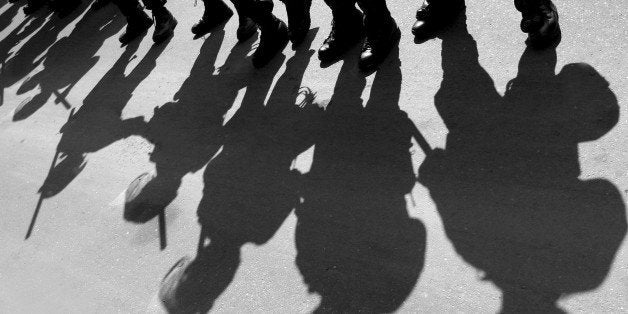
In the span of just over a week, two prominent proponents of Broken Windows theory, the policing strategy that cracks down on low-level infractions, backtracked on the role of the theory in lowering crime across New York city and suggested the theory was 'oversold'.
Malcolm Gladwell, the influential author, told CNN's Fareed Zakaria that he, along with others, had 'oversold' Broken Windows over the years. Gladwell's 2000 book, The Tipping Point, strongly supported the premise that the NYPD's Broken Windows crackdowns were the primary cause for New York City's crime declines of the '90s. NYPD Commissioner Bill Bratton himself, who ushered in the Broken Windows era then, often cites Gladwell's book when promoting the theory.
A few days after that, George Kelling, co-author of the 1982 magazine article that birthed Broken Windows, defended his trademark theory on The Takeaway, NPR's national morning radio show. He insisted that he and Bratton's goal was "not to arrest people" but to "persuade" them. Today's critics, he suggested, simply had "misconceptions" about the theory which, he lamented, could sully all the "progress" Broken Windows had made. Still, he warned that "it's easy to oversell Broken Windows, and I don't want to do that either."
Was Broken Windows, the most ironclad staple of policing over the last few decades, losing its appeal in just a matter of months? To be sure, the outcry over Broken Windows truly entered mainstream discourse after the killing of Eric Garner in Staten Island last Summer. Garner had been approached, according to police, for selling 'loosie' cigarettes on the street when police choked him to death. His death, as well as his long history of low-level arrests, was completely traceable to the Broken Windows policing model. Many of the thousands of protesters who filled the streets and blocked bridges in December certainly made that connection, calling for an end to the Broken Windows era.
However, outcry and criticism were hardly new developments. Affected communities and grassroots groups had denounced mass criminalization and Broken Windows' aggressive zero-tolerance approach for years. Academic research had also challenged the causal link between the theory and declines in crime. Bernard Harcourt, whose studies and 2001 book Illusion of Order undermined the theory's assertions and forced Bratton and Kelling's defensively-written 2006 rebuttal There Are No Cracks in The Broken Window, sat alongside Gladwell during that CNN interview perhaps feeling vindicated.
Clearly there were now glaring political cracks in the Broken Windows image. A theory practically sacrosanct in political circles for years was becoming the focus of protesters and being questioned like never before. A flurry of articles began to attack the theory. But Gladwell's notable change of tune apparently had not yet registered on Bratton's radar shortly thereafter as he and Kelling made the media rounds to attack their detractors. After brushing off critics who "don't know what the hell they're talking about" in an interview on the local Inside City Hall show, Bratton referenced Gladwell on the New York Times Closeup as he defended Broken Windows -- not knowing that Gladwell had distanced himself from it less than a week prior.
On the heels of the massive protests of December, Bratton and Kelling's interviews and op-eds signaled a sort of damage control on their part. They wrote pieces like The Assault on Broken Windows, via the Wall Street Journal, and Why we need Broken Windows policing, for City Journal in an attempt to push back against the growing criticism. City Journal is the quarterly magazine published by the notorious conservative think tank, the Manhattan Institute, where Bratton's crackdowns are cheered and Kelling is a senior fellow. CUNY Law's Professor Steve Zeidman astutely pointed out Bratton and Kelling's tag team attempts to reframe the Broken Windows debate by emphasizing less-welcomed offenses their theory might deter -- like fighting or public drinking -- while omitting the non-violent offenses young men of color as well as homeless people are routinely targeted for (i.e. riding bikes on sidewalks, sleeping in staircases, etc).
Still, a city poised to move past their thinking was bleeding the legitimacy out of their ideas. Ironically, a two and a half week work slowdown, which saw cops from all boroughs renege on the mass arrests and summons game that Broken Windows perpetuates, added a new level of skepticism that further turned their logic on its head. A New York City without thousands of arrests, fines and summonses for non-violent infractions didn't see crime to go up over a three-week span. While protesters and critics could be admonished or ignored, what was the theory without willing street soldiers to carry it out?
There's a cautionary tale here as well. The cracking of the Broken Windows myth, previously perhaps unthinkable, also saw a small admission come out of Kelling. In his NPR interview he conceded that its creators knew all along its "enormous potential for abuse." Kelling's revisionist telling of the Broken Windows story included the canard that mass arrests were never its intent -- begging the question as to where he had been the previous twenty years of Broken Windows that saw low-level arrests balloon by 200 percent in the city. Observers should be wary that Kelling's hedging around Broken Windows, his crowning achievement, might be done in an effort to save the theory in its broader form. It's the public policy equivalent of being sorry you got caught.
Bratton, on the other hand, responded much more aggressively.
In a speech late January he somehow managed to promise improved police-community relations by way of the mythical 'community policing' model and also announce a machine-gun-toting "Strategic Response Unit" tasked to deal with terrorists -- and protesters -- in the same breath. Without skipping a beat, Bratton advocated a friendlier NYPD and militarized response to protests at the same time. After a highly predictable backlash from people taken aback by the anti-terrorist posture towards protesters, Bratton's number two, Chief O'Neill, walked back the statement and insisted the 350-member unit may not, in fact, handle protesters.
Clearly Bratton was pushing the limits of his power as he flexed the department's muscle. He was also carefully reframing the Broken Windows debate by linking the theory with 'community policing', an always-useful PR buzzword that sounds oh so agreeable. The New York Times article that reported the Bratton speech blurred the lines quite well:
As an example of what the new patrol model might look like on the street, Mr. Bratton drew from his own experience the day before: As he was getting his shoes shined, he observed a group of men, with "their booze stuffed in the two phone booths," who were harassing people outside the shop, he told reporters after the speech.
Mr. Bratton directed officers from his security detail to call the local precinct. Soon, two of the men were under arrest.
It was a quintessential moment of "broken windows" policing by the commissioner who has championed the strategy, which has come under criticism for its focus on minor disorder as the best way to prevent major crime.
"This is the heart of community policing," he said.
At Mayor de Blasio's State of the City on February 3rd, policing was hardly mentioned -- even as some of us protested the Mayor's support of Broken Windows just outside. But while the Mayor avoided the topic, Bratton was on the offensive again one day later testifying alongside police union president Pat Lynch in front of a New York State Senate Committee. Aside from Lynch's denunciation of the quota system and hedging on Broken Windows, the pair agreed that cops were under attack and needed more resources. Bratton made the case for more cops with Lynch asking for over 6,000 more boots on the ground. Bratton also said it would be "very helpful" if the state upped the penalty for resisting arrest (often a charge used to cover instances of brutality) to a class A felony. This, many will note, would carry huge ramifications with it.
Capping off a remarkable seven-day stretch where Bratton had publicly threatened protesters, announced a new heavily armed special forces style unit, rebuffed calls for independent prosecutors, asked for more resources and street soldiers, Bratton and de Blasio held a press conference to announce new bulletproof vests at a cost to the city of $7.3 Million. The vests, described as "rolls royce" quality, were made by Paraclete, who makes tactical body armour for the Army and has a "following among the international defense community" for its "high-performance ballistic systems." Their logo, found on the breastplate of NYPD's new vests, was the image of a shield from the Crusades.
You couldn't make this stuff up.
Ultimately, if the goal is to end the Broken Windows era then the conversation must be kept away from attempts, both genuine and disingenuous, to simply reform it. It must be ended. That Broken Windows could be uprooted in New York, where it started, would be the most fitting end to its dark chapter in city history. However an ever-growing police state must also be minded. The political power of the NYPD is seemingly only matched by its firepower as our elected officials stumble over themselves to give the department whatever it wants. This dynamic doesn't only ignore protesters nationwide that call for local police departments to be reigned in, it also puts us all in very real danger.
